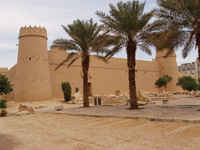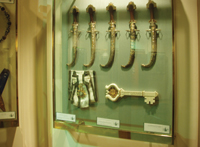
Attractions in Saudi Arabia include a wealth of museums and heritage sites which welcome visitors.
Museums in the capital city, Riyadh, are many and varied and, as often as not, exhibits are labelled in both Arabic and English.
Not unsurprisingly, most museum aficionados head first to the National Museum, located in the centre of Murabba Park, as one of the cornerstones of the King Abdul Aziz Historical Centre. For SR15 ($2.50) you can lose yourself for a whole day in the eight galleries which tell the story of Saudi Arabia from the earliest of times up to the present day.
It is the largest, and without doubt, the most important museum in the whole of the Kingdom.
Unsurprisingly there is a large gallery which tells you everything you could possibly want to know about the life and mission of the Prophet Mohammad (PBUH) from the day of his birth until his journey to Madinah – the event that marks the beginning of the Hijrah calendar. There is also a great deal about the unification of the country under King Abdul Aziz bin Saud.
 |
In the newer part of town are two more museums which should definitely be on any visitor’s itinerary. Inside the King Fahd Library on King Fahd Highway, just south of the Al Faisaliah Tower, is a museum that is dedicated to the preservation of around 300 rare manuscripts and about 10,000 rare books. There is also a small collection of coins from across the Middle East and engraved stonework from the Hijjaz. Amongst the many books are copies of the Qur’an from India and Pakistan, and a Kufi copy which dates back to the third Hijrah century, and which is written on leather.
Just up the road from there inside the Faisal Foundation Building is a very interesting gallery all about the life and times of the late King Faisal containing many artefacts that belonged to him. Here you will find some of his swords (pictured below) and pistols, a mass of ceremonial keys and various medals of honour awarded to him. Signed photographs from statesmen of his era – including Richard Nixon, Lyndon Johnson, U Thant, Nehru, Emperor Hirohito and others – make an interesting display and there are fascinating items such as his first passport issued in Makkah in 1926, which lists his occupation as ‘Viceroy in Hedjaz’. There is also a poignant corner devoted to his assassination which includes some of the items found in his pockets after he was shot.
One of Riyadh’s most enjoyable, but least known, museums is situated on the eastern ring road near junction 10. Put together by the Royal Saudi Air Force, with help from defence firm BAE Systems, the Saqr al Jazeera is a museum dedicated to over 75 years of Saudi aviation. It contains a mixture of models and real aircraft including a number of planes previously in use by the Royal Saudi Air Force – together with aviation equipment. Its prized possession is the now fully restored Dakota DC3 presented to King Abdul Aziz by President Roosevelt and on which visitors are allowed to climb aboard and see how royalty travelled in the early years of Saudi air travel.It is literally a museum with something for everyone including a ‘white-knuckle ride’ near the exit where you are invited to travel into space on a simulator which throws you about with gay abandon as you navigate black holes and avoid a few passing asteroids!
by Brian Salter
